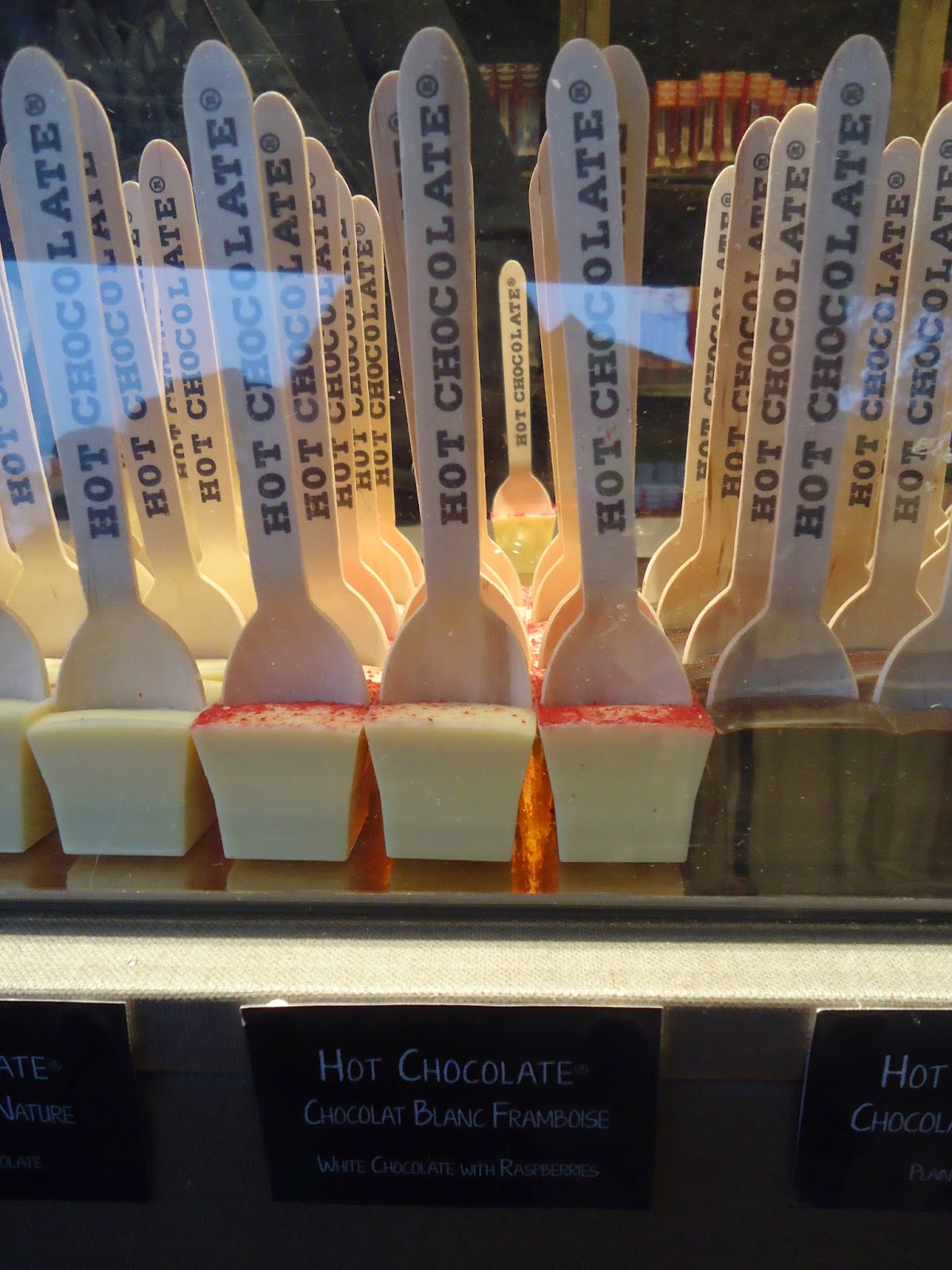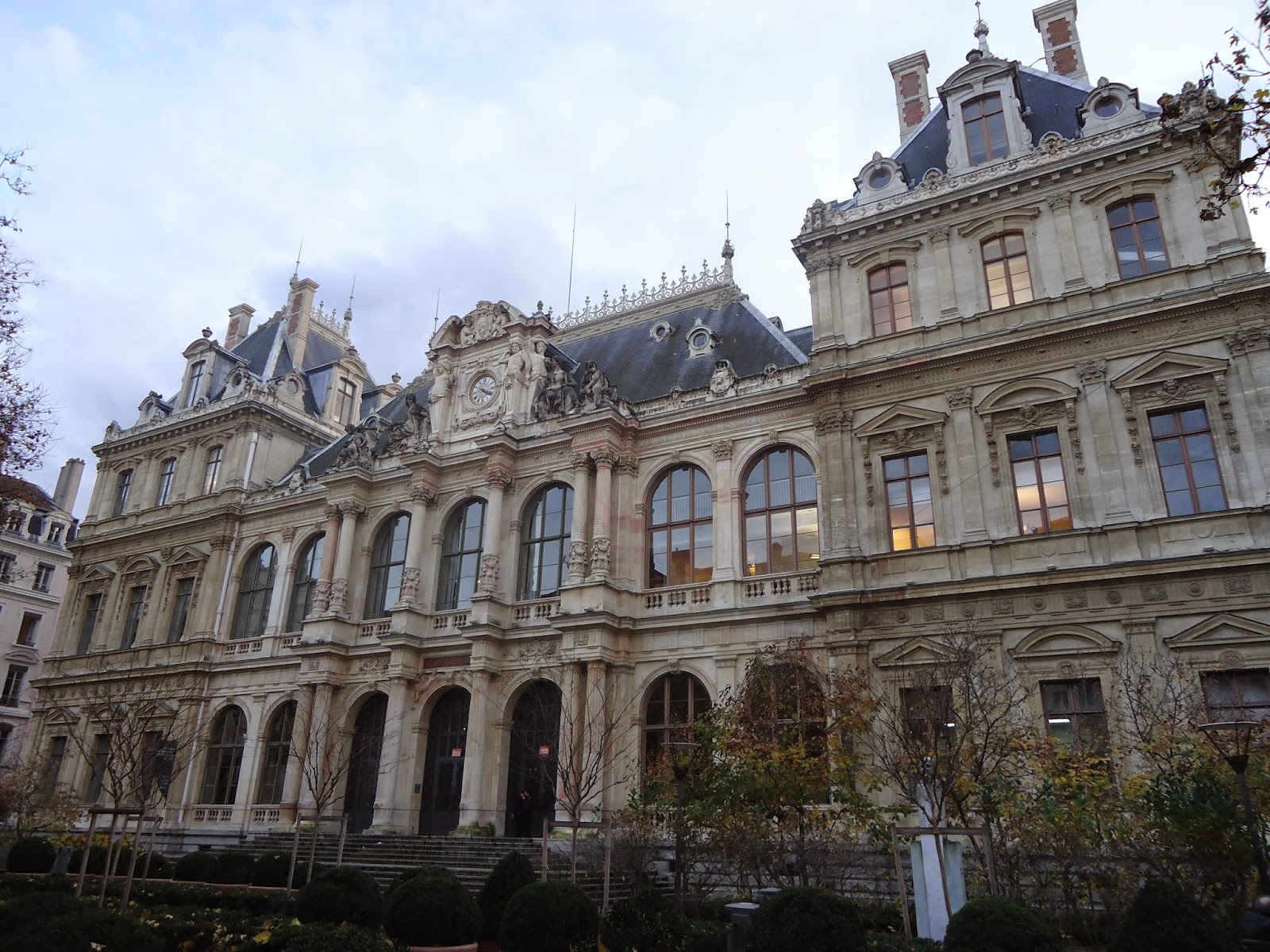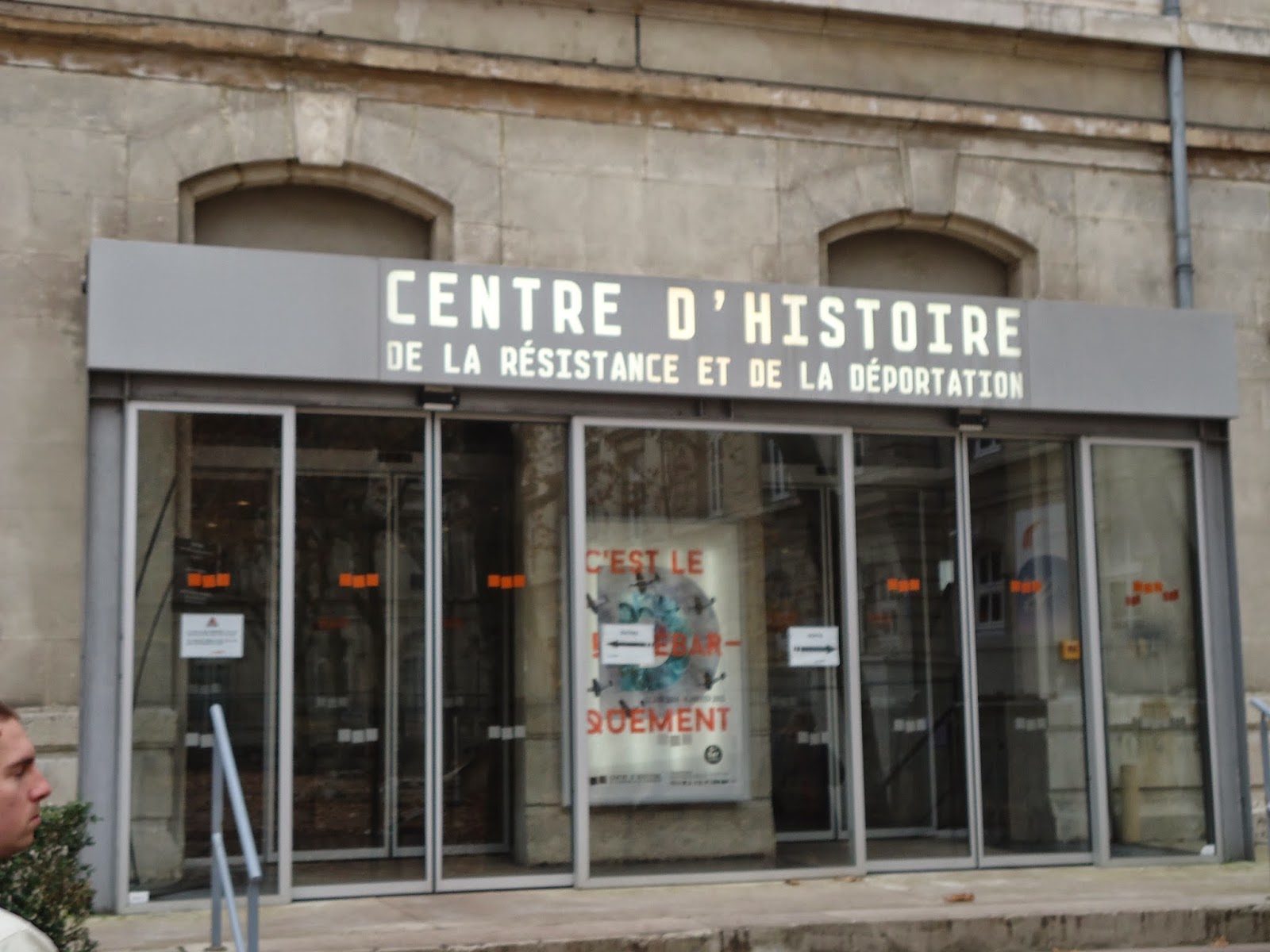This past weekend we decided to forgo the traditional turkey and stuffing of Thanksgiving and instead travel to Lyon, France, which is the gastronomy capital of France.There are more restaurants per Gothic and Renaissance square metre of the old town than anywhere else on Earth. Although we missed the pumpkin pie, Lyon had plenty of delicious alternatives!
We left Germany at 6 a.m. which allowed us to be in Lyon before lunchtime! We walked out of the subway at our stop and the first thing we saw was this enormous Ferris Wheel right in the middle of the Plaza Bellecour. From the plaza, we also had a fantastic view of the Basilica Notre Dame up on the hill.
Our first meal in Lyon wasn't French.....we found this eclectic British fish and chips restaurant just a block away from our hotel room.
After lunch we wandered down the main strip of shops and found a French Christmas market. Although it wasn't nearly as big as the German Christmas markets, we still enjoyed the stalls filled with handmade soaps, jewelry and of course, food!
 |
| We split a dessert: marshmallow covered in dark chocolate |
We spent the rest of the afternoon just exploring the city.
 |
| One of Paul Bocuse's restaurants (Lyon's most famous chef) |
In the Place des Terreaux, there is the Hotel de Ville (City Hall) and an elaborate fountain created by Frederic-Auguste Bartholdi (the French sculptor who also designed the Statue of Liberty).
 |
| Fountain by Frederic-Auguste Bartholdi |
 |
| Hotel de Ville |
Lyon is one of the best cities to view at night; the city is famous for floodlighting. More than 200 buildings are illuminated at night, making the after dinner stroll even more romantic.
We attempted to go to dinner between 6-7 p.m., but we realized the French eat dinner late like the Italians. So we tried again around 8:30 p.m. and found that the restaurants were starting to fill up with patrons. Like the Germans, once you claim a table at a restaurant, it's yours for the rest of the night. Waiters don't rely on tips for their income, so they don't care if you stay for hours. One of our travel guide books said "The French don't do dinner and a movie on date nights, they just do dinner."
We found a little restaurant called "Le Winch." We decided on their prix-fixe menu, which allowed us to chose different options from their 3-course menu.
For starters, I chose the beef carpaccio with cheese, and Chris chose the duck and cheese in a flaky pastry.
For our entrees, Chris chose ribs with fries and a salad, while I chose fresh pasta with chicken and mushrooms.
For dessert, Chris chose tiramisu, and I chose creme brulee. Our desserts were fantastic...we ate every last bite! They were so good we forgot to take a picture of them!
On Friday, we took a funicular up the hill to visit the Notre-Dame Basilica. The church was built in 1872 when a bishop of Lyon vowed to build a tribute to Mary if the Prussians spared the city. The city was indeed spared and so more than 2,000 workers began constructing the church.
Inside, the entire church is covered with mosaics; from the floor to the walls to the ceilings.
 |
| Scene of Pope Pius I proclaiming the dogma of the Immaculate Conception. To the right of the Pope, is the image of the Virgin of Lourdes, the Marian apparition seen by Bernadette Soubirous in 1858. |
 |
| Louis XIII offers the crown of France to Mary |
 |
| View of the city from outside the church |
 |
| The Virgin Mary looks over the city of Lyon |
 |
| We found the Ferris Wheel; our hotel is very close by |
 |
| This is the original church |
After the church, we went down the hill a little ways to explore the Roman theater ruins. Before it was Lyon, the Roman city of Lugdunum stood in its place in 43 A.D. The larger theater held 10,000 spectators, but today it only holds 3,000 for concerts. How cool is it to watch entertainment in the same seats that the Romans did thousands of years ago?
We then visited the Gallo-Roman Museum, which highlighted the importance of Lyon (Lugdunum) in Roman times.
 |
| An elaborate sarcophagus |
 |
| Bronze chariot used for ceremonies |
 |
| Tombstones |
 |
| Precious stones used to create the floor of the Roman theaters |
 |
| View of the theater from the museum |
Then we went back up the hill to have lunch at Restaurant Panoramique with the most spectacular view of the city.
 |
| Trying the Beaujolais Nouveau wine |
We just so happened to be in France right after the release of the Beaujolais Nouveau wine, a red wine made from Gamay grapes produced in the Beaujolais region of France. It's fermented for just a few weeks before being released for sale on the 3rd Thursday of November.
Again, I ordered from the multi-course menu. I started off with a salmon appetizer, followed by an unidentifiable, but tasty, dish, and I finished with an apple dessert. Chris had pike with lobster sauce
 |
| Salmon appetizer |
 |
| Chris' dish |
 |
| Amanda's main course: the mystery dish |
 |
| Apple dessert |
 |
| The funicular we took down the hill |
We spent most of our afternoon in Vieux Lyon (Old Lyon). This area was once the capital of Europe's silk industry from the 16th to 19th centuries. Traboules (passageways) acted as shortcuts for the silk workers, who used the passageways to move the unfinished silk goods from one stage of production to the next without exposing them to the elements.
The traboules also became useful again during World War II, when Resistance fighters used them to slip in and out to outsmart the Nazis.
Several of the traboules are still accessible today. You wouldn't even know where they were if it wasn't for the plaques next the to door marking the entrances. Residents still live in these buildings and use the passageways to access their homes.
 |
| A courtyard inside one of the traboules |
 |
| Looking up at the different apartments inside the traboule |
 |
| We saw signs all around the city announcing the arrival of their favorite wine |
 |
| A puppeteer during a street performance |
 |
| Ferris Wheel at sunset |
We went back to the little Christmas market and enjoyed the music of a marching band.
We were stopped on our way to dinner by a roller blade race.
Bouchons are casual bistro-like restaurants in Lyon. In the late 19th century, bouchons dished out hearty meals for working-class customers. "Bouchon" originated as a term for the bundles of straw that hung over the entrance, indicating the availability of food and drink for horses as well as their owners. Nowadays, many restaurants call themselves a "bouchon", but a true bouchon will have a little plaque by the door showing Gnafron, a drunken marionette with a red nose and a wine glass in his hand. Bouchons are very small, quaint restaurants that are usually always full. We were turned away from a couple because we did not have a "réservation."
 |
| Our authentic bouchon, with Gnafron out front |
 |
| Our cozy, authentic restaurant |
We knew we weren't in a touristy restaurant when the menu was only in French and all the other patrons seemed to know the waiters personally. We again ordered off the pre-fixed menus (with the help of our waiter translating it for us.) I decided to be adventurous and just point to random things on the menu and see what I got. Chris' appetizer was a salad with egg and herring. My appetizer was marinated veal. For entrees, Chris chose a classic Lyonnais dish, sausage in a red wine sauce. I again chose at random, and ended up with a delicious chicken liver mousse with little raviolis. For dessert, Chris chose chocolate mousse and I chose pears soaked in red wine.
 |
| Chris' salad with egg and herring |
 |
| My marinated veal |
 |
| Chris' sausage with a red wine sauce |
 |
| My chicken liver mousse with ravioles |
 |
| Chris' chocolate mousse |
 |
| My pears soaked in a red wine sauce |
On our last full day, Saturday, we headed out of the shopping district to the Resistance and Deportation History Center. The permanent exhibit explained the importance of Lyon which General Charles de Gaulle called the center of the French Resistance. There were dozens of locations around the city used for hideouts, weapons caches, or drop off points. Included in the museum were hundreds of artifacts and documents collected and donated to the museum, including a piece of the famous Resistance fighter Jean Moulin's parachute, as well as a printing press used in secret to print their anti-Nazi pamphlets.
 |
| Parachute equipment |
 |
| Sabotage equipment |
 |
| Places in Lyon with significant Resistance strongholds or events |
 |
| Book of Remembrance |
The traveling exhibit was about D-Day. Chris was very pleased to see this exhibit.
 |
| A cricket, used to identify if that noise in the dark is friend or foe. |
 |
| A letter from Dwight D.Eisenhower to the troops |
For lunch, we stopped at "Monna Lisa", an eclectic Italian restaurant. The pizza was good, but once you've had true Italian pizza, nothing else compares!
As we were leaving the restaurant, we came across a pastry shop, so we had to get a macaroon for dessert!
We walked a good distance down to an area known as La Confluence, which is where the two rivers of Lyon come together. It is an up-and-coming area of town with a huge mall and very modern buildings.
 |
| The confluence of the rivers |
 |
| Some very modern apartment buildings |
 |
| Electric cars |
We went back to the Christmas market (yes, for the 3rd time!) and enjoyed a casual dinner sampling food at some of the vendors.
 |
| Hot chocolate: Just mix the spoon in hot water! |
 |
| Chris tried a bison burger from a stand featuring Cuisine de Québec |
 |
| It was cold enough for hats! |
 |
| My loaded baked potato, with onions, bacon and French cheese |
 |
| A vendor making Gâteau à la broche, a well-known dessert from the Pyrenees |
 |
| For our final dessert in Lyon, we elected to go with a crêpe |
The final morning we just relaxed in our hotel room before heading to the airport.
 |
| Modern sculpture near our hotel |
We were sad to see that the Fete des Lumieres was the following weekend. They were already setting up all over the city! Artists create light installations at various locations all Lyon.














































































































No comments:
Post a Comment